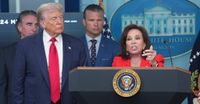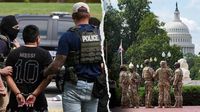On a sweltering August morning in 2025, Washington, D.C., found itself transformed. Military vehicles rolled out from the D.C. Armory, National Guard troops in uniform fanned out along the National Mall and Union Station, and federal law enforcement officers joined local police on the streets. The reason? President Donald Trump’s unprecedented federal crackdown on crime and homelessness in the nation’s capital—a move that has sparked both praise and protest, and left the city’s residents and leaders grappling with a new reality.
The operation, formally launched on August 7 with the creation of the "Making D.C. Safe and Beautiful" task force, escalated sharply on August 11 when Trump invoked the District of Columbia’s Home Rule Act. This rarely used law allowed the president to seize control of the Metropolitan Police Department (MPD) for up to 30 days, placing it under direct federal authority. According to Fox News, this is the first time in U.S. history such a measure has been taken, and it came with the deployment of about 800 D.C. National Guard troops and more than 1,800 personnel from 22 multi-agency teams.
President Trump justified the federal takeover as an emergency response to what he described as a crisis of crime and public disorder. “We have a capital that’s very unsafe. … Something’s out of control. But we’re going to put it in control very quickly,” Trump declared at a press conference on August 11, flanked by Attorney General Pam Bondi and Defense Secretary Pete Hegseth (Reuters).
In the first days of the crackdown, federal and local authorities made a visible impact. On August 11 alone, 23 arrests were made, targeting suspects wanted for murder, gun offenses, and other crimes. White House press secretary Karoline Leavitt confirmed that charges included homicide, weapons violations, lewd acts, and stalking. Six illegal firearms were seized that day. FBI Director Kash Patel highlighted the operation’s momentum, posting on X, "When you let good cops be cops they can clean up our streets and do it fast. More to come. Your nation’s Capital WILL be safe again."
But the numbers soon ballooned. By August 16, according to a White House official cited by Fox News, the crackdown had resulted in more than 240 arrests and the seizure of 38 guns. The sweep netted gang members, robbery suspects, drug distributors, and immigration violators. On August 15 alone, 52 people were arrested—including 28 illegal immigrants—and three more guns were confiscated. Federal teams also cleared 25 homeless encampments, with officials emphasizing that these removals were carried out without confrontations or arrests.
White House deputy chief of staff for policy Stephen Miller called the scale of the operation "breathtaking," telling Fox News Live, "We have seen a record number of violent offenders, bad guys, gang members and all kinds of threats to public safety removed off the streets as well as their illegal weapons that they've been using to terrorize the citizens of this city." Miller also pointed out that over 70 homeless encampments had been dismantled and that the National Park Service was busy erasing gang graffiti from public spaces—an effort he said had been neglected for decades.
The federal mobilization didn’t stop with D.C.’s own National Guard. On August 16, West Virginia announced it would send between 300 and 400 Guard troops to Washington, while South Carolina pledged 200 and Ohio committed 150 more in the coming days. West Virginia Governor Patrick Morrisey expressed his support for the president’s mission, stating, “West Virginia is proud to stand with President Trump in his effort to restore pride and beauty to our nation’s capital.” Maj. Gen. James Seward, the state’s adjutant general, added that his Guard members “stand ready to support our partners in the National Capital Region.”
Despite the show of force, the actual role of the National Guard has been somewhat limited. Troops have been observed conducting foot and vehicle patrols at landmarks and assisting with crowd control, but they have not been authorized to make arrests. Their main duties have included securing federal assets and providing cover for law enforcement operations.
Not everyone in D.C. has welcomed the federal intervention. On August 16, demonstrators gathered in Dupont Circle before marching to the White House, carrying banners that read, “No fascist takeover of D.C.” and “No military occupation.” Many protesters voiced concerns that the president was using crime as a pretext to impose federal control over a largely Democratic city. Morgan Taylor, one of the protest organizers, said, “I can’t believe that this is happening in this country at this time.” Others, like longtime resident John Finnigan, questioned the necessity of the crackdown, noting, “Crime is down. Hopefully, some of the mayors and some of the residents will get out in front of it and try and make it harder for it to happen in other cities.”
City officials have been caught in a bind. D.C. Mayor Muriel Bowser met with federal officials to discuss coordination and strategy, telling reporters, “What I’m focused on is the federal surge and how to make the most of the additional officer support that we have.” Bowser described the federal action as “unsettling and unprecedented,” and in a letter to residents wrote, “Our limited self-government has never faced the type of test we are facing right now.” She acknowledged that her administration’s hands were tied under the Home Rule Act, leaving them little choice but to comply and adapt.
The federal takeover has also sparked political pushback. Democrats in Congress introduced a joint resolution to oppose the move, arguing that it undermines local control and sets a dangerous precedent. Some city leaders have bristled at the scope of the president’s actions, particularly after the administration attempted—then reversed—a plan to install the head of the Drug Enforcement Administration as an “emergency police commissioner.” Attorney General Pam Bondi subsequently directed the MPD to cooperate with federal immigration enforcement, regardless of local laws.
Statistics have become a battleground in the debate. While the Trump administration cites a crisis of public safety, city officials and the U.S. Attorney’s Office report that violent crime is at a 30-year low, down 35% from 2023 to 2024. FBI data, however, shows a smaller decrease of around 9%, highlighting discrepancies in how crimes are classified and reported. The administration’s critics argue that the president is exaggerating the problem to justify an extraordinary assertion of federal power.
For now, Washington, D.C., remains under federal oversight, its streets patrolled by a mix of local police, federal agents, and National Guard troops from across the country. The outcome—both for the city’s public safety and its cherished autonomy—remains uncertain. But as Mayor Bowser urged in her letter, the city’s residents are determined to show the nation what it means to fight for democracy, even when the odds are stacked against them.

